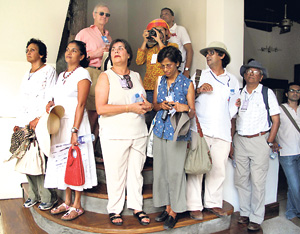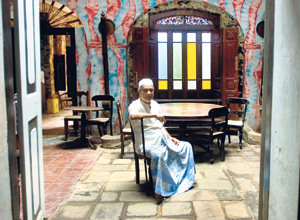| One true advantage of the Galle Literary Festival is its location. The mighty walls of this 17th century maritime citadel are both romantic and relevant, providing both inspiration and awe. A UNESCO World Heritage site, Galle Fort’s narrow streets, towering ramparts, white-washed homes, historic buildings and evocative ambience combined to create perfect settings for exhibitions and talks, dinners and tours.
The diversity of fringe events of this year’s literary festival in late January provided many opportunities for visitors to escape into this magnificent setting, whilst also affording them the chance to explore the expressiveness of Galle’s verdant hinterland. From art and photography exhibitions to scrabble competitions, from cycling and architectural tours to a full children’s literary programme, and from literary lunches and culinary dinners to nights where authors and the general public rubbed shoulder to shoulder, there was something to suit everyone’s taste.
 |
| All set for Channa Daswatte’s tour of the Fort |
The soaring ceilings and huge windows of the extensively restored old Dutch warehouses either side of the Old Fort Gate provided award-winning Sri Lankan photographer Lal Hegoda the perfect place to showcase his beautiful Sri Lankan photographic exhibition.Karl Steinberg of the Galle Fort Hotel also staged a small photographic exhibition in his local landmark as well as hosted an entertaining scrabble competition, which was held over three nights on the hotel’s convivial verandah.
Photojournalist Juliet Coombe exhibited her unique photography exhibition Ways of Seeing in and around Hospital Street aimed to expose the plight of children in Galle villages who suffer from impaired vision and blindness. Her exhibition was two-fold in that it allowed sighted people to enjoy the words, pictures and colours of her exhibits, which were spread between her house, Hospital Street and alcoves of the restored British powder magazine that sits below the lighthouse, whilst the shapes and textures also enabled visually impaired children and adults to benefit in their own unique way. From wrapped chairs to newspaper cut-outs, it was one of the more exciting exhibitions on show.
The Fort House hosted a small collection of iconic wildlife photographs by Gehan de Silva Wijeyeratne, CEO of Jetwing Eco and one of the island’s foremost wildlife photographers whilst Adopt Sri Lanka, a charity set up after the tsunami to assist the region’s schools, held an exhibition of children’s art - My Sri Lanka - in the crumbling Old Bakery, just off Pedlar Street. It gave visitors a chance to not only gain an insight into the quality of some 150 students’ work from 20 schools in and around Galle, but to glimpse Sri Lanka’s life and culture.
Literary fringe events included the launch of Manuka Wijesinghe’s newest book Theravada Man, set in rural Ceylon at the turn of the 20th century. Entertaining the audience in the Hall de Galle was not only the author but also some of her friends who performed parts of the book to the lamentations and ditties of the era. A very well-attended free event was the 60 seconds debate which saw a panel moderated by Amal Jayasinghe of AFP debate on pressing media issues such as whether media institutions should be owned by the state or how to expose the human element of a conflict off-limits to reporters, the idea being that each panellist had only 60 seconds to answer the moderator or audience’s questions. This lively debate was the most engaging, and perhaps most open, discussion of topical issues in this year’s festival.
 |
| On the walking tour: A glimpse of the hidden world of Galle Fort. Pix by Juliet Coombe |
Literary lunches and dinners in private homes and villas were a sell-out, as usual, providing unique chances for fans to engage their favourite authors in conversation. Workshops also afforded a limited number of attendees the chance to learn more about their chosen field, such as travel writing, poetry, theatre and screen writing, through in-depth discussions with experts and informal Q&A sessions. Guided tours also remained popular this year; architect Channa Daswatta’s sell-out The Once and Future Fort educated a cosmopolitan mix of people on the ageing architecture of this colonial citadel.
Future literary greats were kept entertained with their own two-day programme at the Thomas Gall International School and The Lighthouse Hotel. Events including performing, poetry, singing, drawing, writing and painting as well as treasure hunts and team games were enjoyed by three age categories of equally smiling, happy children. Renowned children’s author Michael Morpugo entertained all ages with his engaging storytelling.
One of the highlights of the fringe events was Dead Man’s Tales held in the courtyard of The Sun House. The huge frangipani tree glowing with bright fairy lights was surrounded by a sea of people relaxing on mats and cosy cushions, enjoying the evening as a glittering gathering of renowned writers such as Germaine Greer, Tahmima Anam, Moses Isegawa, Pico Iyer, Colin Thubron and Michael Morpurgo read from the works of their favourite literary heroes. The intimacy of the occasion as other writers joined in with the entertainment or took a back seat along with the rest of the audience is unique to the Galle Literary Festival and one of the reasons it has become so popular. People feel involved, the atmosphere is jovial and writers are accessible, not hidden away.
The historic Closenberg Hotel, sited on a promontory overlooking the harbour and fort, was fittingly host to a brace of events. There was theatre on Friday night where one-act plays, Midnight Train and Por La Libertad by Seneka Abeyratne could be enjoyed from the verandah in the cool evening air. On Saturday, guests could enjoy Stories at Sunset; entertainment by a selection of new and emerging Sri Lankan poets, playwrights and novelists led by distinguished writers Yasmine Gooneratne, Anne Ranasinghe and Vivimarie Vanderpoorten. Followed by music and dancing, it was an important event for Sri Lankans writing in English.
The Concert at Dusk performance by the excellent Chamber Music Society of Colombo in the ethereal setting of the Dutch Reformed Church provided an extra special festival treat. Led by Artistic Director and Concert Master Lakshman Joseph de Saram, the musicians entertained and enthralled an audience that spilled onto the street with powerful and moving performances of the works of Bach, Mozart, Albinoni, Dreyer and Khemadasa.
Offering festival-goers the chance to explore was The Rice Paddy Bicycle Trail where guests enjoyed gentle guided off-road cycle trails through the iridescent green paddy fields, little villages and jungle off the interior of Galle.
|


